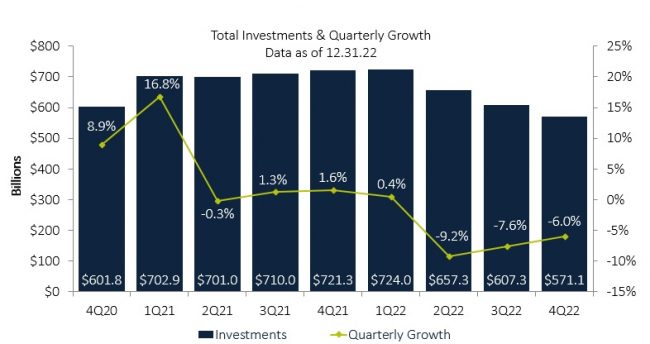 Source: Callahan's Peer-to-Peer Analytics
Source: Callahan's Peer-to-Peer Analytics
As a result of macroeconomic conditions, credit union lending and deposit dynamics changed considerably throughout 2022. In the first half of the year, cooperatives were on a record pace for loan originations in dollar terms, led by consumer lending. However, consumer lending demand slowed in the second half of the year, and high interest rates led to a substantial decline in the pace of the real estate financing market. All told, loan origination dollars declined 3.5% from the record level set in 2021. Despite slowing up-front pipelines, higher interest rates made it more attractive for credit unions to hold loans on balance sheets. Additionally, increasing cost of living brought savings rates down, reducing the pace of both new deposits and early loan paydowns. With the loan-to-share ratio rising and market conditions affecting the sale price of available-for-sale securities, many credit unions are dealing with liquidity pressures. In turn, credit unions are borrowing funds and making their certificates of deposit more attractive in order to meet loan requests.
Investments Fall $36.2 Billion From September
Total investments – including cash – held by U.S. credit unions fell 6.0%, or $36.2 billion, over the past three months to finish the year totaling $571.1 billion. The decrease marked the third consecutive quarter of decline. Much like last quarter, the contraction in the investment portfolio came from a surge in loan balances and a deceleration in share growth. According to Federal Reserve Economic Data (FRED), the average personal savings rate for the quarter was 4.0%, the third lowest rate in the past 10 years. A high cost of living is driving members to fund their accounts at a slower pace than before while also turning to credit unions for borrowing needs. This left credit unions with less available funds to meet member loan demand. Share balances at credit unions contracted $8.6 billion since September while outstanding loan balances increased $50.0 billion in the same period, causing net liquidity to decline by $58.5 billion. In all of 2022, net liquidity declined $188.7 billion – an unprecedented amount in a relatively short timeframe. Most of this lending was funded through the repurposing of investment balances, which declined $150.2 billion (20.8%) across the year. This is a completely different dynamic than last year, when cooperatives had substantial excess liquidity that many converted into longer-term investment products. With loan balance growth outpacing share growth, the loan-to-share ratio for the industry reached 81.4% in December. While this remains below the average levels reported pre-pandemic, credit unions also have less in the way of relative cash balances. Going forward, credit unions will need to find ways to bolster their cash position or find other creative sources to fund the borrowing needs of their members.
Recommended For You
Cash On Hand Increases, Total Cash Balances Fall
The only category that saw an increase in dollar terms from the previous quarter was cash on hand, up 8.2%, or $2.0 billion. In total, cash balances fell to $131.0 billion during the year, down $23.0 billion or 15.0% since last quarter. Securities balances also shrank, contracting $13.1 billion – or 2.9% – since September to $440.1 billion at year-end. Aside from the contraction, the industry's investment portfolio composition was little changed from the previous quarter. CFOs kept most funds in government and federal agency securities, comprising 58.5% of total investments at year-end 2022, 1.7 percentage points higher than in September. The growing proportion of securities in the portfolio is occurring due to a relatively larger decline in cash balances. While it remains the largest cash-holding partner for credit union investors, cash held at the federal reserve fell 21.2% from last quarter, the largest percentage decline across all investment categories. Until fixed income security prices rebound, cash will continue to be drawn down as decreases in the value of investment securities are leading credit unions to hold them to avoid realizing losses.
 Source: Callahan's Peer-to-Peer Analytics
Source: Callahan's Peer-to-Peer Analytics Industry Yield Reaches 1.63%
The average yield on investments increased 25 basis points quarter-over-quarter to 1.63%. Although still far from pre-pandemic investment returns, this was the first time on record that yields rose by over 20 basis points in each of the last three quarters, reflecting the unique dynamics at present. The surge in yield in the past three quarters comes as securities portfolios reprice to rapid rate increases by the Fed. Additionally, credit unions are converting billions of low-yielding cash into higher-yielding loans, which bolsters the average yield of the investment portfolio through the decline of its lowest yielding segment. High interest rates can benefit credit unions through additional short-term revenue. For instance, in the fourth quarter alone, cooperatives received over $3.4 billion in income from investments, a 17.9% increase compared to the third quarter despite a significantly smaller overall portfolio of investment assets. However, with rising rates come falling bond prices, which hurt credit union available-for-sale securities through unrealized losses. 2022 ended with $38.0 billion in unrealized losses, leaving many credit union portfolio managers unwilling or unable to convert most of these securities into more liquid funds and realize the loss.
 Source: Callahan's Peer-to-Peer Analytics
Source: Callahan's Peer-to-Peer Analytics Jay Johnson is President of Callahan Financial Services, Distributor of the Trust for Credit Unions, in Washington, D.C.
© Touchpoint Markets, All Rights Reserved. Request academic re-use from www.copyright.com. All other uses, submit a request to [email protected]. For more inforrmation visit Asset & Logo Licensing.






